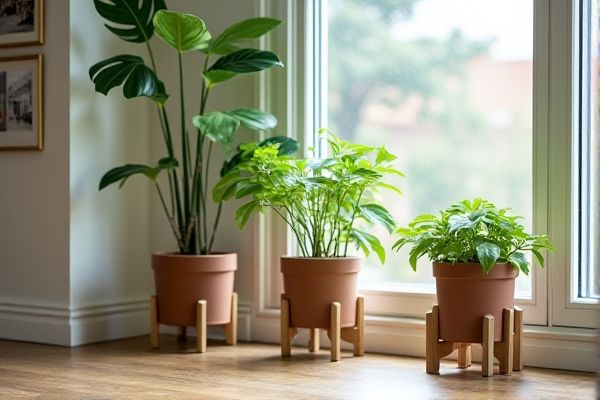
A plant caddy offers mobility and stability for heavy pots placed on floors or patios, while a hanging planter maximizes vertical space and adds decorative charm to walls or ceilings. Explore this article to discover which option suits Your gardening style and space best.
Table of Comparison
| Feature | Plant Caddy | Hanging Planter |
|---|---|---|
| Purpose | Mobility for potted plants, easy relocation | Elevated plant display, space-saving design |
| Placement | Floor or flat surfaces | Suspended from ceilings, walls, or hooks |
| Material | Plastic, metal, wood with caster wheels | Ceramic, metal, plastic, woven materials |
| Space Utilization | Utilizes floor space efficiently | Frees floor space, ideal for small areas |
| Plant Types | Usually for larger, heavy pots | Suitable for trailing, small to medium plants |
| Maintenance | Easy to move for cleaning and watering | Requires regular inspection for secure hanging |
| Cost | Generally affordable, depends on materials | Varies widely based on design and material |
Introduction to Plant Caddies and Hanging Planters
Plant caddies offer mobility for heavy pots, featuring wheels or casters to easily reposition indoor or outdoor plants without lifting. Hanging planters save floor space by suspending plants from ceilings or walls, ideal for small areas and adding vertical greenery. Each option enhances plant display and care based on space constraints and aesthetic preferences.
Design and Functionality Comparison
Plant caddies offer a mobile and sturdy design with wheels or casters, allowing easy repositioning of heavy pots, ideal for optimizing sunlight exposure and indoor cleaning. Hanging planters maximize vertical space, creating visually appealing displays while keeping plants off the ground, but they require secure mounting and limit mobility. Your choice depends on whether you prioritize flexibility and convenience with a plant caddy or aesthetic elevation and space-saving with a hanging planter.
Space Optimization: Floor vs. Vertical
Plant caddies optimize floor space by allowing you to easily move and rearrange larger pots, perfect for maximizing usable area in limited rooms. Hanging planters utilize vertical space, freeing up floor area while creating visually appealing layers at eye level or above. Your choice depends on whether you prioritize mobility and surface coverage (plant caddy) or vertical space efficiency and decor enhancement (hanging planter).
Mobility: Moving Plants with Ease
Plant caddies enhance mobility by providing a sturdy base with wheels, allowing heavy pots to be effortlessly moved across floors without lifting. Hanging planters, while space-saving, require detachment from hooks or supports to relocate, making them less convenient for frequent movement. For gardeners prioritizing ease of transport, plant caddies offer superior flexibility in repositioning plants indoors or outdoors.
Weight and Load Capacity Considerations
Plant caddies typically support heavier pots with robust wheels designed to handle substantial weight, often up to 100 pounds or more. Hanging planters rely on ceiling anchors or hooks, with load capacities varying based on installation, generally supporting between 10 to 30 pounds safely. Proper assessment of plant weight and secure mounting hardware is essential to prevent damage and ensure stability for both options.
Accessibility for Watering and Maintenance
Plant caddies offer easy accessibility for watering and maintenance by allowing you to roll your plants to any location, reducing the need to lift heavy pots. Hanging planters often require reaching or the use of ladders, which can complicate daily care routines and limit accessibility for those with mobility issues. Your choice will affect how effortlessly you can nurture your plants and keep them healthy.
Aesthetic and Decorative Impact
A plant caddy offers a sleek, mobile base that enhances the aesthetic by elevating floor plants and allowing easy repositioning to optimize room decor. Hanging planters create a dynamic visual impact by suspending greenery at eye level or above, adding layers and dimension to your living space. Your choice between the two depends on whether you prefer grounded elegance or floating botanical accents for your interior design.
Suitable Plant Types for Each Option
Plant caddies are ideal for larger, heavier plants such as indoor palms, ferns, and snake plants that require stable support and easy mobility. Hanging planters suit trailing or vining plants like pothos, philodendrons, and spider plants, maximizing vertical space and enhancing aesthetic appeal. Choosing between the two depends on plant size, growth habits, and space availability.
Indoor vs. Outdoor Usage
Plant caddies are ideal for indoor usage due to their mobility and ability to protect floors from water damage, making them perfect for heavy pots and large indoor plants. Hanging planters are more suited for outdoor environments or bright indoor spaces where they can maximize vertical space and provide better air circulation for plants. Both options support plant health, but plant caddies excel in easy repositioning and maintenance, while hanging planters optimize sunlight exposure and space efficiency.
Choosing the Right Option for Your Home
Selecting between a plant caddy and a hanging planter depends on your space and aesthetic preferences. Plant caddies offer mobility and stability, ideal for heavy pots on floors or patios, while hanging planters save floor space and add vertical interest, perfect for small rooms or balconies. Consider plant type, sunlight access, and room layout to enhance both functionality and decor.
 homyna.com
homyna.com